Astronaut Gus Grissom
Astronaut Virgil "Gus" Grissom
By Sam Beddingfield
I first met Gus Grissom in 1957 at Wright Patterson Air Force Base. We were in flight test together. I was an aeronautical engineer and Gus, a fighter pilot, was one of the test pilots. We flew several test flights together.
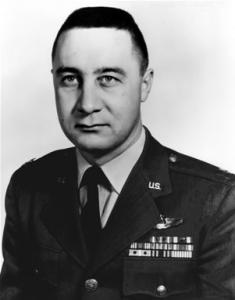 Capt. Virgil Ivan "Gus" Grissom
Capt. Virgil Ivan "Gus" Grissom
U.S. Air Force portrait.
Photo: Courtesy U.S. Air Force
The most memorable was the last flight we took together. We were assigned to perform some in-flight observations and tests on a B-47; a jet bomber. We took off first in a two seater F-100F with Gus at the controls in the front seat. The B-47, however, didn't get off the ground due to mechanical problems.
With the B-47 tests canceled, Gus had a suggestion. "Let's see what you think of the performance modifications on this aircraft — why don't you try it out and see how you like it?"
I took over the controls, lit the afterburner, and tried out a few routine maneuvers. I had the controls for almost an hour and Gus had made a few comments, but was quiet most of the time.
Towards the end of the flight, Gus hadn't spoken for over 15 minutes, and I had seen the fuel gauge rapidly dropping, but no word from Gus. So when we got down to 700 lbs I finally said "Hey, Gus, we're down to 700lbs, of fuel."
I didn't get an answer. So I shook the stick a few times violently left to right to rock the plane side to side and this woke Gus up. He had fallen asleep!
"Where are we?" asked Gus.
"I think we're heading back to base, but I can't tell. We're down to 700lbs of fuel." I answered.
Calmly Gus said "I've got it."
Gus turned the radio to the correct frequency and said, "Patt Tower, this is Drumhead 5."
Drumhead 5 was Gus's call sign at Wright Patterson. "We're ready to land."
The tower responded "We don't see you."
"You soon will," Gus replied.
We were still at 35,000 feet!
With that he rolled the aircraft into a steep descent, took us into a normal flight pattern, and we went in for a perfect landing and had just enough fuel to taxi back to the ramp.
Looking back I realize the danger we were in, but at the time I had no concerns, I had total confidence in Gus's abilities — he inspired that kind of confidence. His timing as a pilot was very precise, he knew exactly what he had to do in any circumstance, and knew how to execute the maneuver.
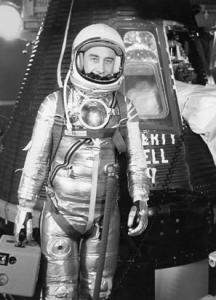 Astronaut Gus Grissom in front of Liberty Bell 7
Astronaut Gus Grissom in front of Liberty Bell 7
July 21, 1961
Photo: Courtesy NASA
I got out of the Air Force just about the time that Gus was selected as one of the Mercury 7 astronauts. I went into farming in North Carolina which lasted three days when I realized that farming was not for me.
The newly formed NASA had just begun operations. I was two hours' drive from Langley Field, Virginia and I'd heard that they were doing flight testing. So I went over to take a look with the hope of getting hired as an aeronautical engineer to do flight tests on aircraft, but they didn't have any open slots. They recommended that I go talk to the rocket people which was in a separate building on the other side of the runway. So I went over, and the first person I ran into was Gus Grissom.
"What are you doing here?" Gus asked.
I explained that I'd come looking for a flight test position.
Gus suggested I try for an open position on rocket testing.
I told him that I didn’t know anything about rockets.
“Neither do they!” was Gus’s response.
He noticed that I wasn't in uniform, and I explained that I had just left the air force.
"That's perfect," he said, "if you don't like it you can just get up and leave."
I applied and got the job. I was only at Langley for 10 days before being reassigned to Cape Canaveral to work on Project Mercury.
For Gus's flight, Liberty Bell 7, I was responsible for weight and balance of the spacecraft, the escape rocket, the retrorockets, the posigrade rockets, the drag chutes and main chutes, and pyrotechnics including the explosive charge designed to fracture the bolts that held the hatch door in place.
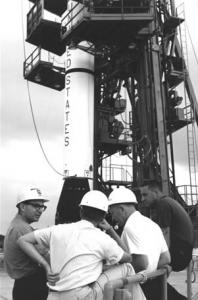 Sam Beddingfield ( left ) talking with two other engineers in front of MR-4, the rocket that would take Grissom into space.
Sam Beddingfield ( left ) talking with two other engineers in front of MR-4, the rocket that would take Grissom into space.
Gus Grissom joined in the discussion and is seated on the rail ( right.)
Photo: Courtesy NASA
Liberty Bell 7, after a 15 minute flight, landed safely in the Atlantic Ocean about 300 miles downrange. While waiting for the helicopter to pick up the capsule to take it back to the carrier, the hatch suddenly blew. Gus was rescued from the water, but the capsule sank and was lost.
Gus insisted that he did not fire the hatch, and an inquiry was held within our group and the conclusion was that the hatch had indeed blown by itself. To blow the hatch required a very hard strike with the back of the hand to prevent accidentally setting it off. Everyone that ever fired a hatch manually, had a strike mark on the back of their hand — Gus had no such mark after he was picked up.
I was a member of the inquiry team, and we found three or four different ways that the hatch could have blown by itself. Knowing Gus as well as I did, I am certain that if he had blown the hatch manually, he would have told me.
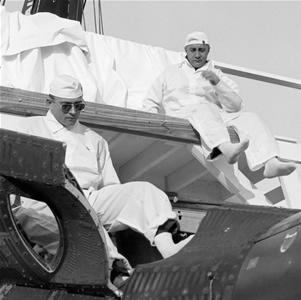 John Young (left ) and Gus Grissom the crew for Gemini 3 - the first manned Gemini flight.
John Young (left ) and Gus Grissom the crew for Gemini 3 - the first manned Gemini flight.
Photo: Courtesy NASA
The Gemini Flight with Gus Grissom and John Young aboard was the first manned Gemini flight, and was a very successful mission that paved the way for future multi manned spacecraft missions.
Friday January 27, 1967 was scheduled to be my last day as part of the Mechanical Engineering division. The following Monday I was due to move to the Apollo Program Office. At 6:31 pm on Friday, during a routine ground test, the AS 204 ( later renamed Apollo 1 ) capsule exploded in flames at Pad 34 killing all three astronauts on board — Ed White, Roger Chaffee and Gus Grissom.
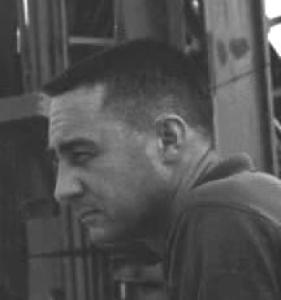 Gus Grissom at Pad 5.
Gus Grissom at Pad 5.
June 22, 1961.
Photo: Courtesy NASA
I had just returned to Pad 34 from Cocoa Beach after getting something to eat when the explosion occurred. I was deeply saddened at the loss of these fine young men including my good friend Gus Grissom. At the same time I had been in flight testing long enough to know that accidents happen, and it was my job to help find out what went wrong and help prevent a future occurrence.
It was Gus Grissom who got me into the space program. He was an outstanding pilot and a very good friend.
Sam Beddingfield
USAF aeronutical engineer.
Joined NASA as an aeronutical engineer in Sept. 1959.
Retired from NASA on November 1st, 1985 as Deputy Director of the Space Shuttle Program.






